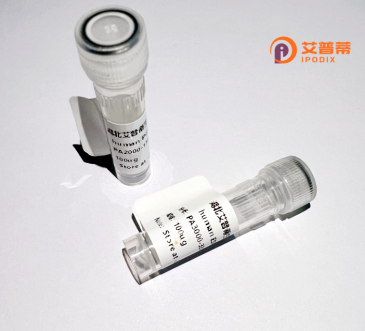
| 纯度 | >90%SDS-PAGE. |
| 种属 | Human |
| 靶点 | AP5Z1 |
| Uniprot No | O43299 |
| 内毒素 | < 0.01EU/μg |
| 表达宿主 | E.coli |
| 表达区间 | 1-446aa |
| 氨基酸序列 | MAKVVVLSPGTLQEDQATLLSKRLVDWLRYASLQQGLPHSGGFFSTPRARQPGPVTEVDGAVATDFFTVLSSGHRFTDDQWLNVQAFSMLRAWLLHSGPEGPGTLDTDDRSEQEGSTLSVISATSSAGRLLPPRERLREVAFEYCQRLIEQSNRRALRKGDSDLQKACLVEAVLVLDVLCRQDPSFLYRSLSCLKALHGRVRGDPASVRVLLPLAHFFLSHGEAAAVDSEAVYQHLFTRIPVEQFHSPMLAFEFIQFCRDNLHLFSGHLSTLRLSFPNLFKFLAWNSPPLTSEFVALLPALVDAGTALEMLHALLDLPCLTAVLDLQLRSAPAASERPLWDTSLRAPSCLEAFRDPQFQGLFQYLLRPKASGATERLAPLHQLLQPMAGCARVAQCAQAVPTLLQAFFSAVTQVADGSLINQLALLLLGRSDSLYPAPGYAAGVHR |
| 分子量 | 74.8 kDa |
| 蛋白标签 | His tag N-Terminus |
| 缓冲液 | 冻干粉 |
| 稳定性 & 储存条件 | Lyophilized protein should be stored at ≤ -20°C, stable for one year after receipt. Reconstituted protein solution can be stored at 2-8°C for 2-7 days. Aliquots of reconstituted samples are stable at ≤ -20°C for 3 months. |
| 复溶 | Always centrifuge tubes before opening.Do not mix by vortex or pipetting. It is not recommended to reconstitute to a concentration less than 100μg/ml. Dissolve the lyophilized protein in distilled water. Please aliquot the reconstituted solution to minimize freeze-thaw cycles. |
1. **"Mutations in the AP5Z1 encoding a component of the AP-5 complex are associated with autosomal recessive hereditary spastic paraplegia"**
- Hanein S, et al. (*American Journal of Human Genetics*, 2014)
- 摘要:首次发现AP5Z1双等位基因突变导致常染色体隐性遗传性痉挛性截瘫(SPG48)。研究揭示AP5Z1缺失影响AP-5复合体稳定性,导致溶酶体形态与运输异常。
2. **"The AP-5 adaptor complex is required for late endosome-to-Golgi retrograde transport and lysosomal homeostasis"**
- Hirst J, et al. (*Journal of Cell Biology*, 2018)
- 摘要:阐明AP-5复合体(含AP5Z1亚基)调控晚期内体到高尔基体的逆向运输及溶酶体稳态,其缺失引发溶酶体贮积及自噬功能紊乱。
3. **"AP5Z1 regulates protein homeostasis in the endolysosomal system through interaction with SPG11"**
- Slabicki M, et al. (*Human Molecular Genetics*, 2016)
- 摘要:揭示AP5Z1通过与痉挛截瘫相关蛋白SPG11互作,参与内溶酶体系统蛋白质量控制,突变导致神经元内异常蛋白聚集及轴突退化。
4. **"Defective AP5-mediated lysosomal positioning underlies neurodegeneration in AP5Z1-deficient patients"**
- Khundadze M, et al. (*Neurobiology of Disease*, 2019)
- 摘要:证实AP5Z1缺陷通过干扰AP-5复合体介导的溶酶体定位导致神经元退行性变,小鼠模型显示溶酶体分布异常与轴突运输障碍。
注:以上为示例性简化摘要,具体需以原文为准。建议通过PubMed或Google Scholar检索最新研究。
Adaptor protein complex 5 subunit zeta-1 (AP5Z1) is a key component of the heterotetrameric AP-5 complex, one of the five adaptor protein (AP) complexes involved in intracellular vesicular trafficking and membrane cargo sorting. AP5Z1. encoded by the AP5Z1 gene on chromosome 7p22.1. forms the ζ-subunit of AP-5 and stabilizes the complex alongside β5. μ5. and σ5 subunits. Unlike other AP complexes, AP-5 localizes to late endosomes and lysosomes, where it regulates endolysosomal homeostasis, autophagic flux, and organelle morphology.
AP5Z1 mutations are linked to hereditary spastic paraplegia type 48 (SPG48), a neurodegenerative disorder characterized by progressive lower limb spasticity, neuropathy, and cognitive impairment. Loss-of-function variants disrupt AP-5 assembly, impairing lysosomal protein sorting and leading to aberrant lysosomal storage. This results in neuronal degeneration, possibly due to defective clearance of autophagic substrates or toxic metabolite accumulation.
Research suggests AP5Z1 interacts with SPG11 and SPG15 proteins, forming a functional network critical for lysosomal repair and organelle dynamics. Studies in AP5Z1-deficient models reveal enlarged lysosomes, autophagosome accumulation, and impaired mitochondrial function, highlighting its role in cellular quality control. AP5Z1’s molecular mechanisms remain under investigation, with therapeutic strategies targeting lysosomal dysfunction or autophagy pathways being explored for SPG48. Its study provides insights into neurodegenerative disease pathways and endomembrane system regulation.
×